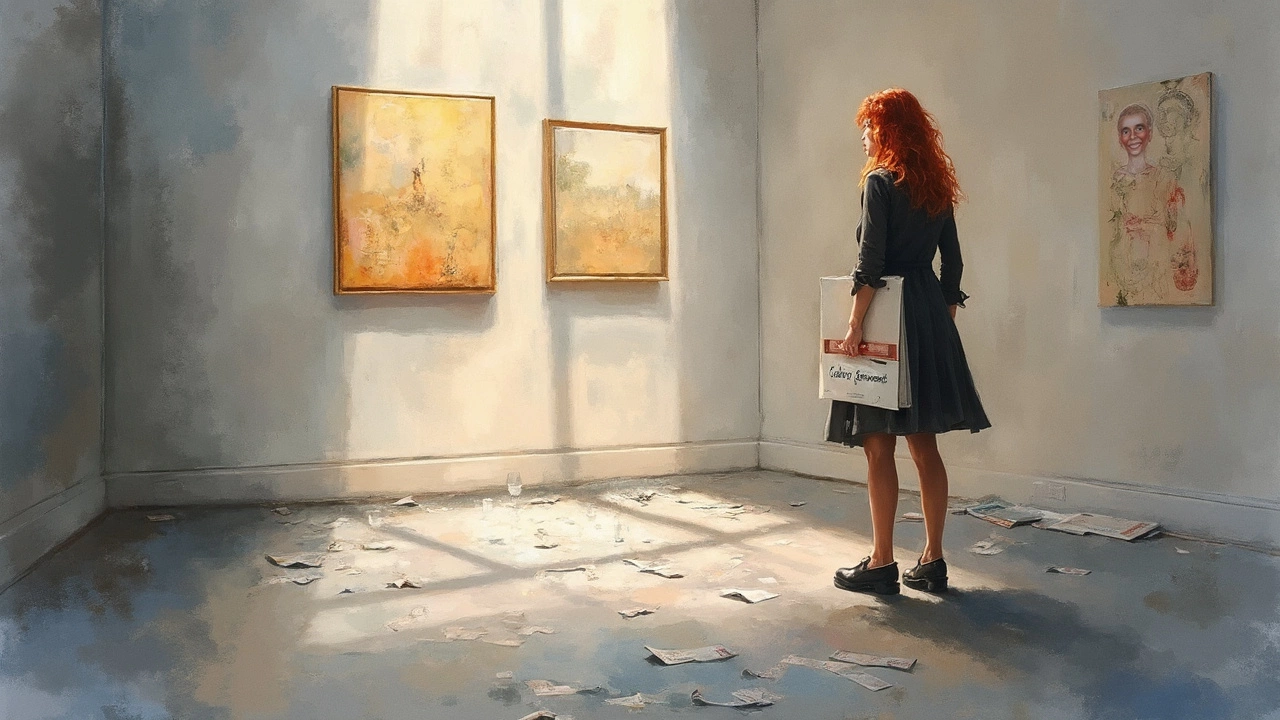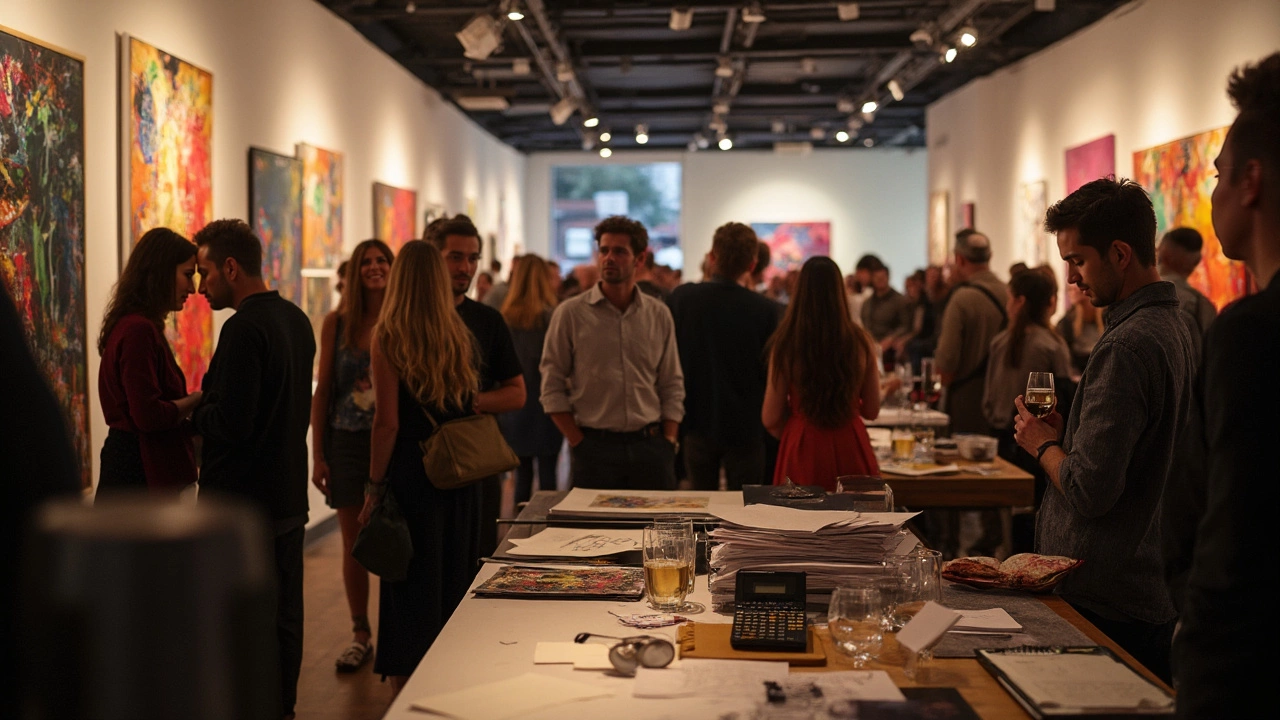Everyone assumes that once you get your art on the wall, the money starts rolling in. Wish it worked like that. In reality, whether artists get paid for exhibitions depends on a surprising list of factors, like the type of gallery, the contract, and sometimes pure luck.
The classic question: do galleries actually pay you to show your art? Most of the time, the answer is no—at least, not just for exhibiting. For many exhibitions, especially in smaller galleries, you're expected to cover your own framing, shipping, and sometimes even a ‘hang fee’ just for the right to participate.
Some bigger shows and top-tier galleries do things differently. They might offer an artist fee, but it's not as common as you’d think. Sales are the main way artists can expect to get paid—usually with the gallery taking a healthy cut, often around 40-50%. That means, if your piece sells for $1,000, you’re more likely to see just $500, or sometimes less after expenses.
- How Payment Works in Exhibitions
- Types of Galleries and What They Offer
- Hidden Costs Every Artist Should Know
- Smart Tips for Artists to Maximize Earnings
How Payment Works in Exhibitions
If you’re wondering whether art exhibitions pay artists just for showing up, here’s the honest scoop: most group shows don’t hand artists a paycheck for their participation. Let’s break down how the money actually moves.
There are basically four ways money might change hands at an exhibition:
- Artist Fees: Rare, but growing in places like Canada or the UK where paying artists to exhibit is sometimes required by law. Not so much in the US, unless you’re invited to a well-funded institution.
- Sales Commissions: The big one. If your art sells, you and the gallery split the profit. The typical cut for galleries is 40-50%, but some take up to 60%—especially established or high-traffic spaces.
- Entry or Hanging Fees: Instead of getting paid, artists often end up paying a fee just to show their work. These fees usually cover event expenses but can run anywhere from $20 to $200 per work.
- Prize Money: Juried shows or competitions offer prize money, but only to a handful of winners.
Here’s a quick look at how this plays out in real numbers:
| Type of Payment | How Common? | Typical Range |
|---|---|---|
| Artist Fee | Occasional | $100–$2,000/show |
| Commission from Sales | Very common | 40–60% gallery cut |
| Entry/Hanging Fee | Common | $20–$200/piece |
| Prize Money | Rare | $50–$10,000 (top prize) |
Don’t be surprised if the first ‘payment’ you see is actually a bill for participation or a taxable sales receipt, not a check.
If you want to actually earn money, it comes down to your work selling or winning a prize. Some artist-run spaces split things differently, but mainstream galleries stick to the sales commission model almost every time.
Types of Galleries and What They Offer
Not all galleries work the same way, and knowing the differences can save you serious headaches (and maybe even some cash). Here’s a breakdown so you can spot what you’re getting into before you hand over your paintings.
- Commercial Galleries: These are the traditional “white cube” spaces you see in big cities. They’re in the business of selling art, and typically invite artists they think will sell. The gallery usually takes a 40-50% commission on any sales. Artists rarely pay to exhibit, but you probably won’t get paid an exhibition fee. The upside? These galleries do their own marketing, which helps get eyes (and buyers) on your work.
- Co-op Galleries: These function like artist-run clubs. Members often pay monthly dues and help run the space. Artists usually split costs, take turns on staffing, and sometimes share sales commissions. Expect to handle your own marketing and bring your own crowd.
- Pop-Up & Alternative Spaces: Think coffee shops, community centers, or empty storefronts transformed for the weekend. These usually don’t pay artists, but you may get exposure to new audiences. Sometimes there’s a small fee to participate, but it can be a low-pressure way to start showing your art publicly.
- Non-Profit & Museum Spaces: These are often more formal and can offer real credibility. Some bigger non-profits and museums pay artists a fixed fee for participating (called a ‘honorarium’ or ‘artist fee’), especially if they get outside funding. But spots are competitive, and the paperwork can be intense.
Wondering how the money side really plays out? Take a look at this quick comparison:
| Gallery Type | Do They Pay Exhibition Fees? | Commission (avg.) | Extra Costs |
|---|---|---|---|
| Commercial Gallery | Rarely | 40-50% | Framing, Shipping |
| Co-op Gallery | No (but you pay dues) | Low or None | Membership, Marketing |
| Pop-up/Alt Space | No | Usually None | Participation Fee |
| Non-Profit/Museum | Sometimes | 10-30% | Application Fee |
If you really care about earning from your art exhibitions, always read the fine print. Some opportunities look great until you realize you’re handing over hundreds just to play. Ask what’s covered before you commit your time or work.
So, which gallery suits you? It depends on your goals. Want sales and a bit of prestige? Aim for commercial or museum shows. Need experience and connections? Start at co-op or pop-up spots. Don’t be shy about asking direct questions—good galleries have nothing to hide when it comes to how they handle artist payment.

Hidden Costs Every Artist Should Know
It’s easy to get excited about showing your work, but wow, the hidden costs of art exhibitions can eat up your wallet before you even hang a piece. Sure, there’s the obvious stuff like framing and supplies, but it goes deeper. Let’s break it down.
- Entry Fees: Some galleries—especially juried shows—charge just to consider your work. Fees can range from $10 to over $100 per piece.
- Shipping and Insurance: Packing art safely isn’t just about bubble wrap. If your art is going overseas, expect big shipping bills. Insurance is a must, often costing between 1-2% of your artwork's value per month.
- Framing and Presentation: Quality framing isn’t cheap. Standard frames for medium pieces start at $50-$200 each, and custom jobs can reach into the hundreds.
- Gallery Commissions: Most galleries take a commission—usually 40%-50% of any sale. Some artist-run spaces still charge a hanging or participation fee on top.
- Marketing and Promotion: Want to get noticed? Sometimes you’re responsible for invites, postcards, or social media ads. These costs sneak up surprisingly fast.
| Item | Low End | High End |
|---|---|---|
| Entry Fee | $10 | $150 |
| Framing | $50 | $300 |
| Shipping (Domestic) | $40 | $200 |
| Insurance (per month) | $20 | $75 |
| Marketing Materials | $30 | $200 |
All in, it’s not unusual for an emerging artist to spend a few hundred to over $1,000 just preparing for one show. Some artists admit they’ve lost money after a solo exhibit, even if they sold a piece or two. People rarely talk about it on Instagram, but it’s real.
A tip: keep every receipt and make a checklist before you commit to a show. The numbers can surprise you—and sometimes, they’ll make you renegotiate with the gallery or skip the show altogether.
Smart Tips for Artists to Maximize Earnings
If you’re hoping to actually make money from art exhibitions, you have to think beyond just showing up with your work. A few small changes—like picking the right galleries, reading contracts closely, and thinking about extra sales—can make a massive difference to your wallet.
- Pick the right galleries: Look for spaces that have a real history of selling art instead of just charging artists a fee. Ask to see their track record or get sales numbers if you can.
- Negotiate your split: Don’t be shy about discussing the commission before signing anything. Typical cuts are 50/50, but some galleries drop to 30-40% if you take on more of the costs or marketing.
- Apply for artist fees and grants: In the UK and Canada, some public galleries pay “exhibition fees” thanks to national organizations like CARFAC or a-n The Artists Information Company. Google what’s available in your area—artist unions can be goldmines for this info.
- Offer prints or smaller pieces: Not everyone can buy a big canvas, but they might spring for a $50 print. Having a few lower-priced items boosts your total sales at group shows and open studios.
- Promote your work: Make it easy for visitors to look you up. A QR code on your label for your site or socials helps you connect with buyers even after the show closes.
- Keep track of costs: From transport to insurance, the bills stack up. Know exactly what you’re spending versus earning—nobody likes finding out they lost money after all the effort.
- Network with other artists: Often, word of mouth from other artists leads to the best paying gigs and tips on which galleries are fair.
Just to give you an idea of real earnings, check out this table with some standard numbers for artist payments:
| Gallery Type | Average Commission Rate | Typical Artist Fee (if paid) |
|---|---|---|
| Commercial Gallery | 40-50% | $0 (sales-based) |
| Public/Nonprofit Gallery | 0-30% | $100-$2,000 (varies by country & funding) |
| Artist-Run Space | Usually none | $0 or modest honorarium |
Not every show will fatten your wallet, but with a few smart moves and a bit of hustle, your chances of actually getting paid for your art start to look much better. Keep learning, stay organized, and don’t sell yourself short—your work is worth it.

